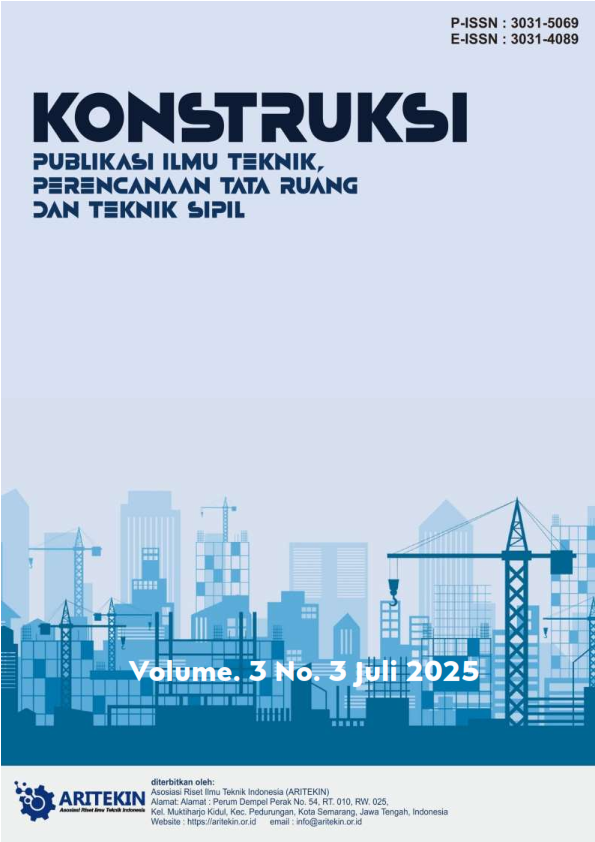Implementasi Konsep Age-Friendly City dalam Menghadapi Tantangan Demografi Lansia di Kota Yogyakarta
indonesia
DOI:
https://doi.org/10.61132/konstruksi.v3i3.925Keywords:
Age-Friendly City, Inclusive City, Spatial Planning, Urban PlanningAbstract
The increasing number of elderly people in Yogyakarta City demands the provision of an inclusive environment that supports the welfare of the elderly. This study aims to assess the suitability of Yogyakarta City for the concept of an elderly-friendly city based on seven main variables: green open space, public transportation, pedestrian facilities, health services, social support, elderly-friendly intergenerational interactions, and advocacy for the basic rights of the elderly. The research used a quantitative approach with observation and questionnaire methods to elderly people in all sub-districts in Yogyakarta City. The data were analyzed using a Guttman scale to determine the level of suitability of each variable. The results showed that overall Yogyakarta City is classified as “suitable” for the concept of an elderly-friendly city, with a total score of 5.32 out of a maximum scale of 6.80. Four variables meet the suitability criteria, namely public transportation, health services, social support, and intergenerational interaction. Meanwhile, the other three variables are still not fully suitable and require improvement. This study recommends improvements in these three aspects so that the implementation of the concept of an elderly-friendly city in Yogyakarta City can be more optimal and sustainable.
References
Australia Government AusAid. (2013). Accessibility Design Guide: Universal design principles for Australia’s aid program. www.ausaid.gov.au
Badan Pusat Statistik. (2024). Statistik Penduduk Lanjut Usia Tahun 2024 (Vol. 21).
Building and Construction Authority. (2007). Universal Desain Guide. Building and Construction Authority.
Halimsetiono, E. (2021). Pelayanan Kesehatan pada Warga Lanjut Usia. KELUWIH: Jurnal Kesehatan Dan Kedokteran, 3(1), 64–70. https://doi.org/10.24123/kesdok.v3i1.4067
Harrison, J. D. (1997). Singapore HOUSING FOR THE AGEING POPULATION OF SINGAPORE.
Kurniawan, H., Ikaputra, & Forestyana, S. (2014). Perancangan Aksesibilitas Untuk Fasilitas Publik. Gadjah Mada Universitas Press.
Kusumo, M. P. (2020). BUKU LANSIA. https://www.researchgate.net/publication/346019144
Nathania, I., Sriwarno, A., & Triharini, M. (2020). Rancangan Bilik Dongeng Sebagai Sarana Interaksi Sosial Antara Generasi Lansia dan Anak-Anak.
Nurazmimar, D. (2023). Implementasi Perlindungan Hukum Dalam Pemberian Pelayanan Sosial Lansia Terlantar Berdasarkan Undang-Undang Kesejahteraan Lansia di Balai Rehabilitasi Sosial Lansia Budhi Dharma Bekasi (Vol. 11). Januari-Juni.
Pemerintah Republik Indonesia. (1998). Undang - Undang Nomor 13 Tahun 1998.
Pemerintah Republik Indonesia. (2017). Peraturan Menteri Sosial Republik Indonesia Nomor 4 Tahun 2017 Tentang Pedoman Pengembangan Kawasan Ramah Lanjut Usia.
Pemerintah Republik Indonesia. (2022). Undang- Undang Republik Indonesia Nomor 2 Tahun 2022 Tentang Jalan.
Prihantika, I., Puspawati, A. A., Sutiyoso, B. U., & Fatharani, F. (2021). Perspektif Ramah Anak, Perempuan, Kelompok Berkebutuhan Khusus dan Lansia Pada Pelayanan Transportasi Publik di Kota Bandar Lampung. Wacana Publik, 15(02), 49–58. https://doi.org/10.37295/wp.v15i2.118
Rabbani, T., & Suryani, T. (2023). Evaluasi Pemanfaatan Taman Lansia Berdasarkan Kebutuhan dan Fungsi Rekreasi Menurut Persepsi Lansia (Vol. 20, Issue 1).
Santika, A., Djamhari, E., Ramdlaningrum, H., & Horman, M. (2020). Pemenuhan Hak Lansia Untuk Hidup Setara.
Setiawan, S. (2021). Hubungan Dukungan Sosial Dengan Kualitas Hidup Lansia Di Rumah pelayanan sosial lanjut usia Pucang Gading Semarang.
Steinberg, F., & Lindfield, M. (2011). Inclusive Cities. Asian Development Bank.
Survey Meter. (2013). Satu langkah menuju impian lanjut usia : kota ramah lanjut usia 2030 [nama kota].
WHO. (2007). Global Age-Friendly Cities : A Guide. World Health Organization.
Downloads
Published
How to Cite
Issue
Section
License
Copyright (c) 2025 Konstruksi: Publikasi Ilmu Teknik, Perencanaan Tata Ruang dan Teknik Sipil

This work is licensed under a Creative Commons Attribution-ShareAlike 4.0 International License.






